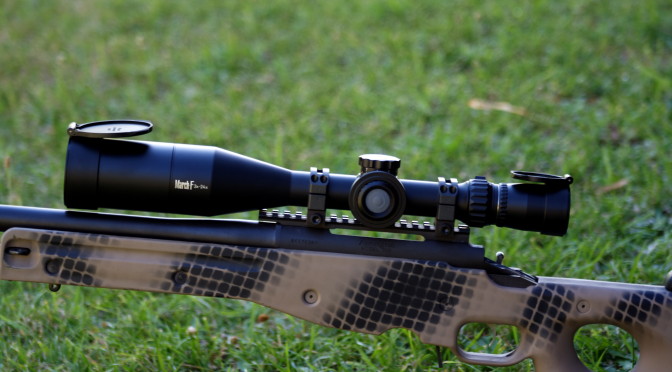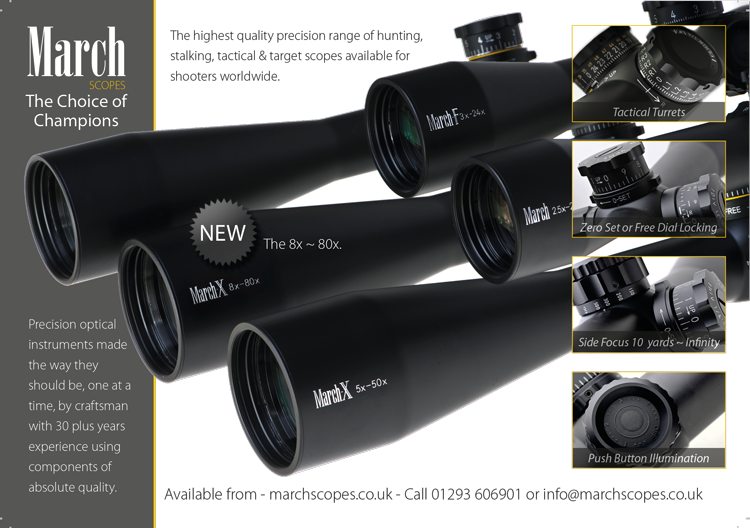Introduction
March scopes have become one of the ‘go to’ choices for the precision shooting elite over the past decade. New models continue to be released each year, with each model benefiting from the feedback received from customers and reviews such as this.
One of the “wouldn’t it be good if…” questions has been getting a bigger front lens for the two models, 3 – 24 x 42mm First Focal Plane (FFP) and the 2.5 – 25 x 42mm Second Focal Plane (SFP) to give a brighter image, especially on dull days.
It seems that I was not the only one to ask March that and the technicians at the Deon factory in Japan have produced a 52mm version of the scope. I have been lucky enough to get one of the first prototypes produced and have been putting it through its paces.
Model Overview
The scope under review is the 3 – 24 x 52mm First Focal Plane model with the FML-1 reticle. The FML-1 reticle has a single 0.1 MIL sized floating dot in the centre of the crosshairs. Each hair is broken into 0.5 MIL divisions with the even MIL hash marks numbered. For metric users the MIL system should be easier than MOA as one MIL at 100 metres covers 10 centimetres.
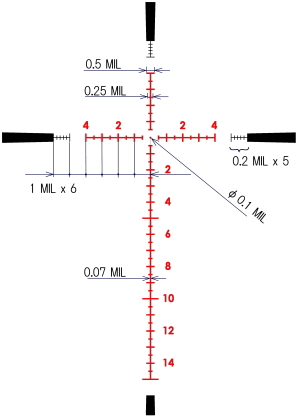
Like the 42mm version, and its bigger brother the 5 – 40 x 56 FFP, this new 52mm version will also be offered in MOA format. The FMA-1 reticle has a ¼ MOA floating dot and the crosshairs are divided into quarter MOA spacings. Another reticle pattern is available; theFMA-2, and it has a 1/8th MOA floating dot and thinner lines. The FML-1 and the FMA-1 are available in an illuminated model but the FMA-2 is only available without illumination as the lines are too fine to illuminate.
All March scopes are lighter in their class than other offerings and the 52mm version weighs only 695 grammes for the illuminated version and less without illumination. Weight with rings comes in well under the magic one kilogramme mark and that is a serious consideration as competition rifles seem to be getting heavier.
| Item | (Low) | (High) |
| Magnification | 3x | 24x |
| Effective Lens Diameter | 52mm | |
| Body Tube Diameter | 30mm | |
| Exit Pupil | 2.17mm | |
| Field of View, real | 6.67°35.0 FT/100YD | 0.83°4.35 FT/100YD |
| Eye Relief | 85-100mm | 89-96mm |
| 1 Click Adjustment | 0.1Mil – 1/4 MOA | |
| Elevation Travel | 34 Mil Rad – 120MOA | |
| Windage Travel | 17 Mil Rad – 60 MOA | |
| Focus | Side Focus / Parallax | |
| Distance | 10YD-infinity | |
| Finish | Matte Black | |
| Reticle (First Focal Plane) | Illuminated FML, FML-1 for Mil RadIlluminated FMA-1 for MOAwithout Illumination FML, FML-1 or FMA-1, FMA-2 | |
| Total Length (-1D) | 336mm (12.3inch) | |
| Weight | 665g (23.4oz) and 695g (24.5oz) for illuminated | |
Hard to Break
There is a turning point in every company’s life when potential problems start to emerge as a result of decisions made years before. It seems that, at about the seven-year mark, customers start reporting the same problems or concerns.
I must admit that, as an early adopter of March scopes, I was conscious that negatives might start emerging about now and these would affect the way I used and viewed the product. But, to date, and despite some very rough and tumble use of my March scopes in competition and hunting, things have remained spot on for me.
In researching for this review it was surprising to hear that, after close to 10 years of production, DEON Optical Design Corporation based in Nagano, Japan has not found any returned scopes to have point of impact changes due to faulty manufacture techniques.
By way of background, the DEON factory is not a high volume assembly line. One engineer is able to assemble no more than two March scopes a day due to the amount of hand fitting required to assemble each unit.
Unlike other brands, there is also no plastic used in the construction of the March. The scope body, for example, is machined from a single piece of aluminium bar stock and all the lenses are glued in. This makes for a structurally solid piece of equipment that is much stronger and lighter than other methods of manufacture.
Turning very technical at this point, non-existent color distortion is possible because chromatic aberration cannot be completely removed in relation to focal length. Extra-low dispersion (ED) glass lenses have been specially designed which deliver a large dispersion ratio for a specific short wavelength zone. With DEON installing ED glass lenses, chromatic aberration is significantly reduced, achieving images with clear colour reproduction, high sharpness and high contrast.
March owners can send their scope back to the factory and DEON are happy to test, dismantle, reassemble and again retest the scope. DEON will also provide a report on what they find. But, to date, there have been no mechanical failures detected which can cause point of impact problems.
March optical perfection is also showing up errors in shooters’ loading technique and equipment and, feedback from a number of March users (including this humble scribe) is that reloading practices have had to be reviewed as a result.
DEON have also offered up a practical example. In October 2012, a house fire destroyed an Australian shooter’s firearms collection. While all the rifles were stored in a safe, the heat from the flames melted lead and plastic parts and destroyed wood and synthetic stocks. The only salvageable item was a 3 – 24 x 42 First Focal Plane scope.
The March scope was sent back to the DEON to see whether it could be repaired. Technicians at DEON had not seen this level of damage to any scope before and were expecting to find internal damage from the fire or the water used to extinguish the blaze.
The scope was fully disassembled and all components checked. No internal damage was found and the March scope required nothing more than a thorough external cleaning to be fully functional. The anodizing and engraved turrets showed the colour distortion effects from the heat of the fire but otherwise were OK.
Unfortunately, the front and rear lenses had suffered damage as a result of the owner’s attempts to vigorously rub them clean but these parts were replaced.
Managing the ‘Eye Box’
Perhaps the most confusing, mis-used and poorly understood term to emerge from the Internet over the past few years relates to a scope’s ‘eye box’. March scopes seem to have attracted some criticism for having a difficult to use ‘eye box’ when compared with other makes and models.
Being an owner and tester of many high end scopes over the past decade, I have struggled with this criticism, especially when it seems to get amplified each time a negative post is made on a forum. Setting up any scope properly has always been an important part of using any rifle, be it for hunting, bench rest or Practical/Tactical shooting. If the scope is not set up correctly then there will certainly be issues when the shooting starts.
Now the term ‘eye box’ appears to be a conflation, or mixing together, of two other scope terms: ‘eye relief’ and ‘exit pupil’ to describe the amount of ‘allowable error in a shooter’s eye relief position, while offering a clear target image and full field of view (FOV). In other words, maintaining an optimum target image and full FOV despite a shooter’s eye being slightly in front of, or slightly behind the optimum eye relief position.
Some focussed time on the Internet suggests that the term ‘eye box’ was created by a major scope manufacturer as an advertising term but has been taken up by shooters. Analysing the complaints made about scopes in general having ‘a poor eye box’ appears to track back to poor eye relief caused by poor scope set up at the beginning.
To test whether this new March model had been affected by the Internet’s ‘eye box’ curse I threw the mounted scope in Farrell rings straight on my long action Remington 700 in an AICS stock and took it to the back garden for some dry firing practices in typical positions for hunting and target shooting and at different magnifications.
It came as no surprise to find there were eye relief problems moving from prone to kneeling and standing as the equipment had not been set up to match either my stock or my height.
Ten minutes levelling the scope and setting up a correct eye relief across the zoom range removed the eye relief issues. Having taken the time to identify the correct eye relief at 24, 12, and 3 power against my normal head position, the scope was set in a position that was perfect for sighting across a range of shooting positions. The time was also used to correctly focus the crosshairs at Infinity for my eyes. After shooting for a 100m zero, the only change I would make is a higher set of rings to better suit my cheek position on the AICS.
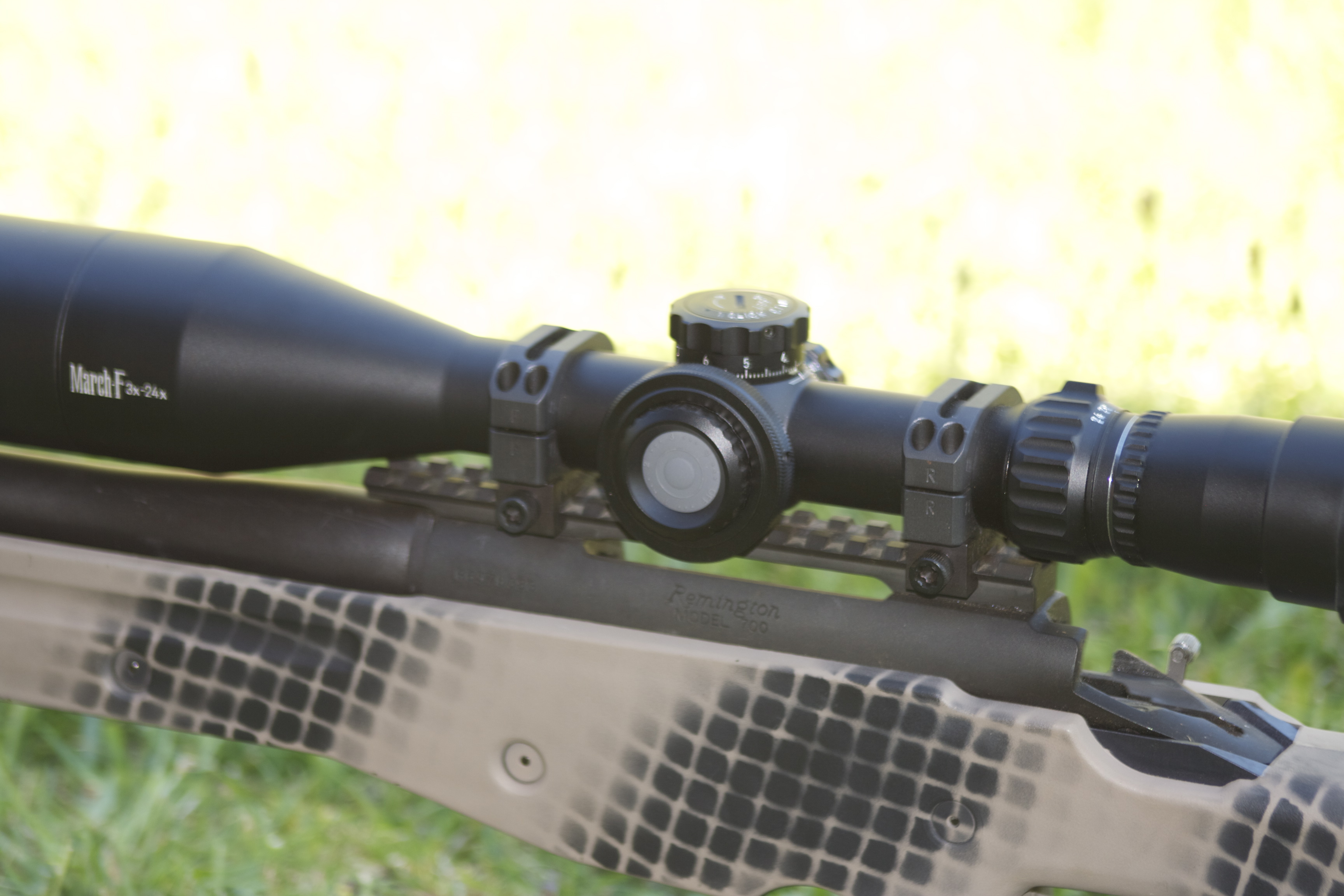
A tricky side focus?
Internet comments have also been critical of the fine focussing adjust on this model and the 52mm version is a bit fiddly in this regard. The relatively short focussing range appears to be a result of a short minimum focus length of 10 yards in a short overall length tube and all March scopes are able to focus from 10 yards to infinity.
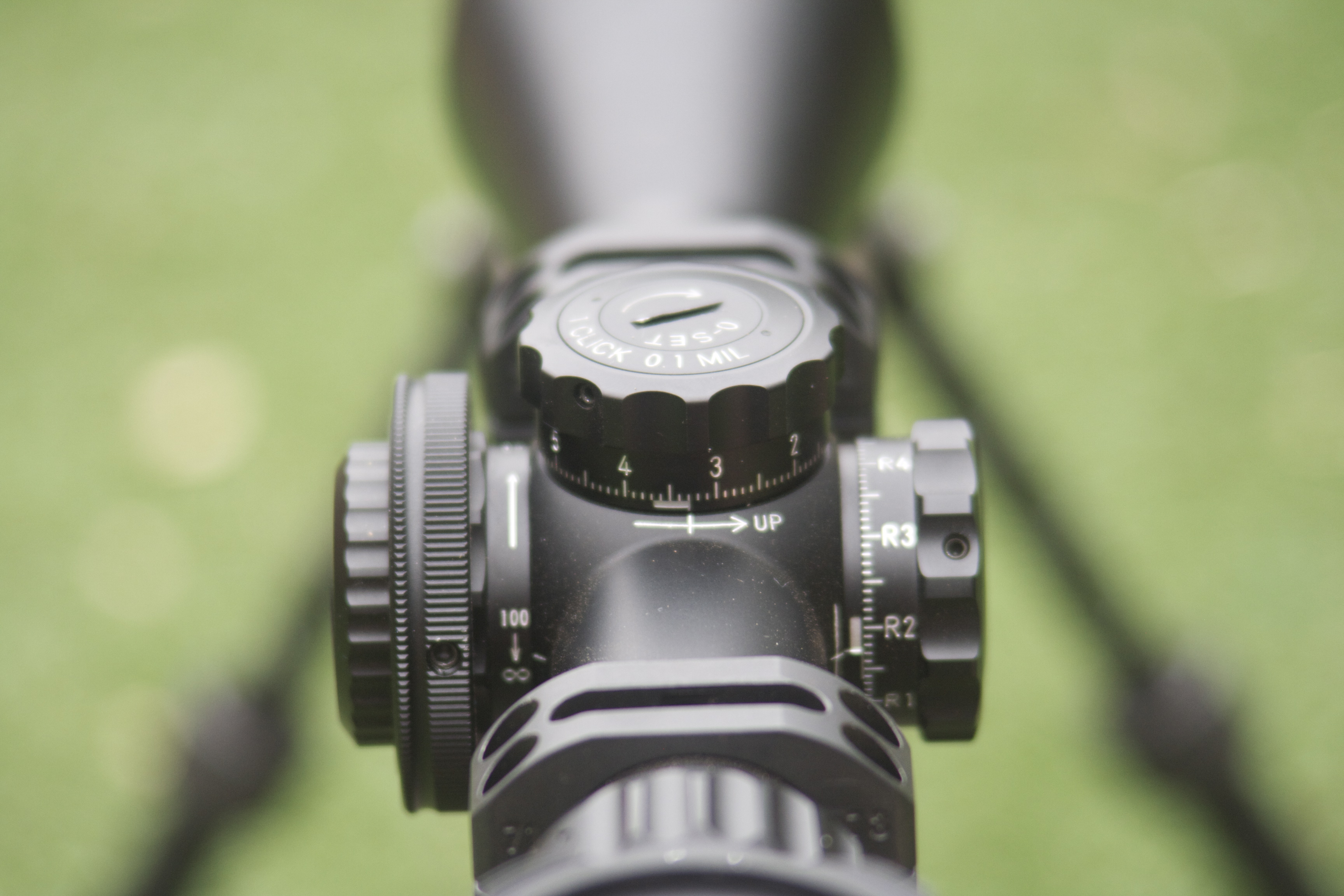
Moving the focus starting point to the conventional 50 yard point used by the majority of scope manufacturers would not change the adjustment range of the focus wheel. Compromises will always have to be made and, in order to decrease the perceived sensitivity of the focus wheel, the scope’s weight and a decrease in the zoom range would need to be increased.
There are workarounds (see below) but this aspect of the scope’s performance will continue to draw undue criticism until it is addressed. The stress is on the word ‘undue’ as a slight change in set up routine and a familiarity with how this model works, means the problem is easily dealt with and accuracy is not affected.
Flip up covers
The 3 – 24 x 52 FFP came with a set of flip up lens covers. These will be standard inclusions on all Tactical model March scopes made from February 2014 in place of the previous leather covers. These are available as an optional extra for those who already own a March scope and prefer flip covers. The leather sets will now become an optional extra also. I have a fondness for the March leather scope covers but they are not the best in wet weather or moving up and down the range. Having a long term dislike of flip up covers, chiefly because the rear one always seemed to move with the zoom, I have been converted with this set.
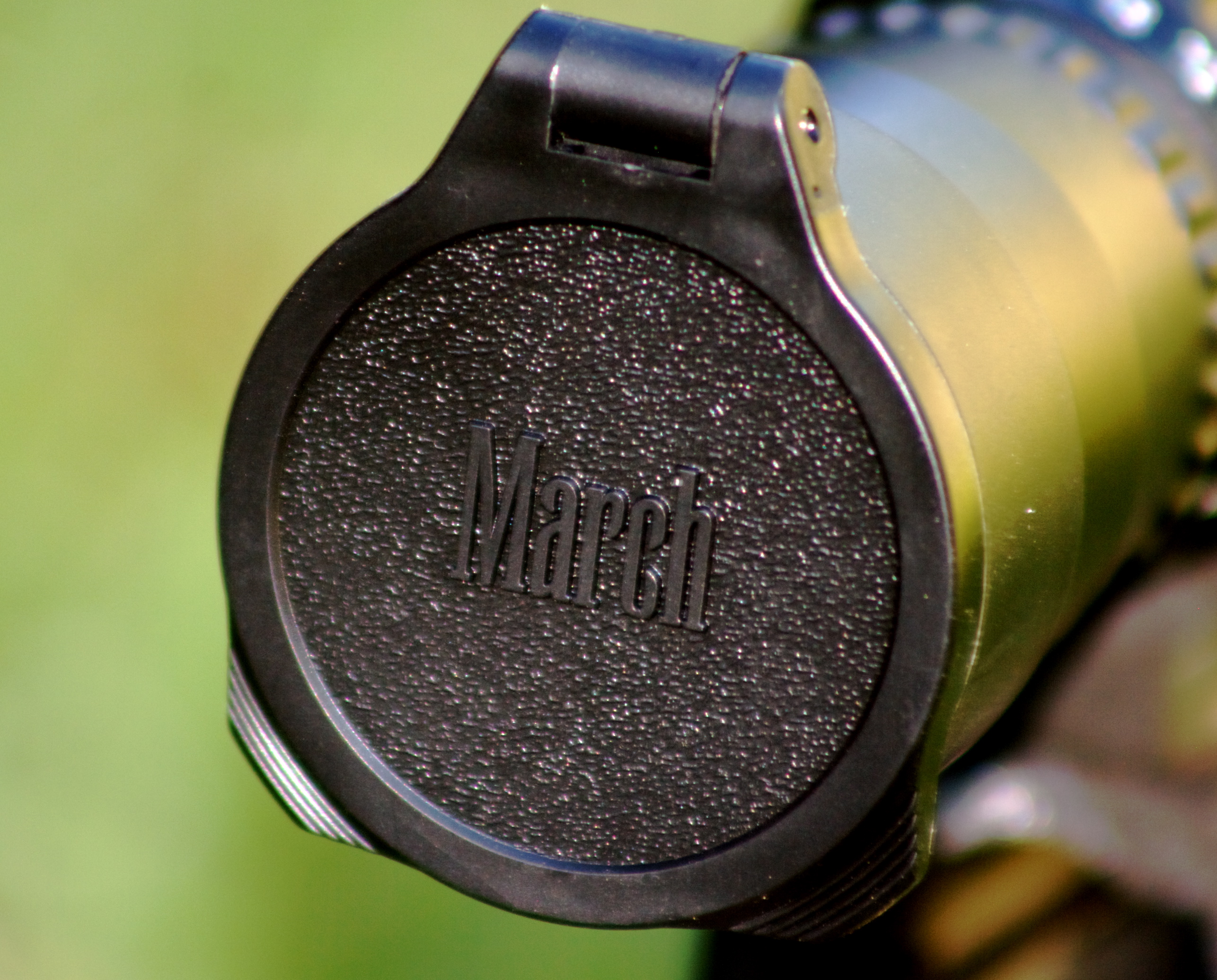
This is mostly because the March zoom is independent of the eyepiece, so these covers stay in the same position all the time. They also lock back when opened and lay flat against the scope body making one less thing to catch on gear. There is also enough room to put your range elevations in the front (or even rear) cover so it can be seen easily in the opened position.
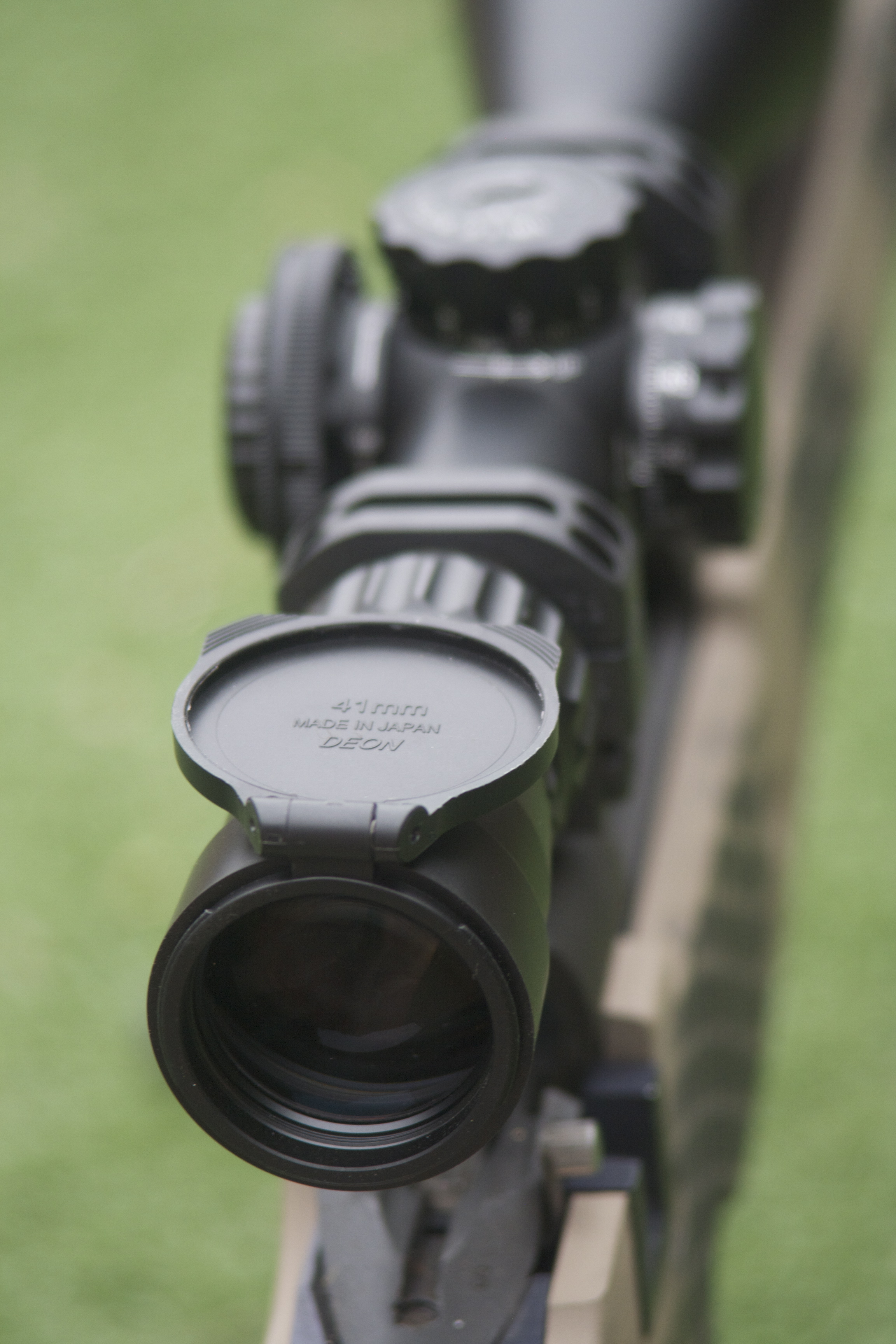
Parallax ring
The scope also came with an attachable ring that slides over the parallax focus ring and increases the knob’s diameter from 33mm to 48mm. The increased diameter certainly helps if you find the fine adjustment of the focussing ring too difficult. The ring is held on with three non-marking delrin screws and stood up to the rigours of several action shooting matches in hot, dusty conditions. This DEON small diameter focus wheel is also an optional extra.
Comparison with the 42mm version
The first question that comes to mind is why do we need a 52mm front lens when the 42mm model is out there already? The one thing I would have changed on my 3 – 24 x 42mm FFP only became apparent when I started hunting deer in the dull light of winter and I wanted to wring as much twilight out of the hunting day as possible.
Comparing the 42mm with the 52mm during the transition from day to night during a recent 300m benchrest match immediately demonstrated the value of the extra glass area at the front of the 52mm model. A March 10 – 60 x 50mm was used on the shooting rifle with the magnification set at 50 power (once again the target was clearly defined at the higher power with a 50mm front lens). Target clarity on the 52mm model was excellent and 7mm bullet holes could be seen clearly at 24 power even in low light conditions. The 42mm model was struggling to pick out the same level of detail in the same light. For example, when the 52mm model could see five holes clearly through the gloom, the 42mm would be able to pick out three.
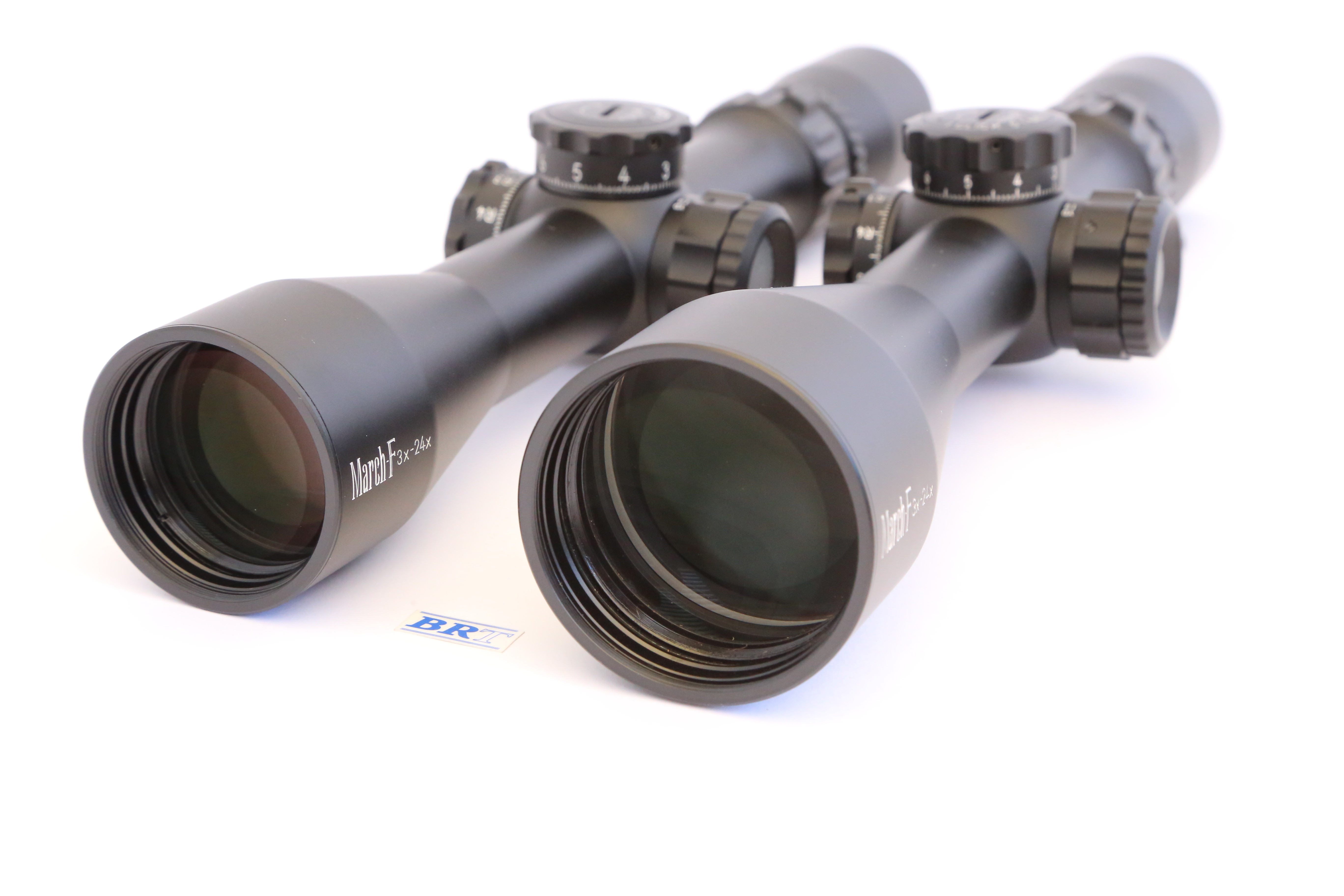
In normal daylight conditions both scopes were clear and were able to see the same details. It was just that the 52mm was noticeably brighter.
Field testing
So how does this scope stack up in competition and out hunting? I removed the 42mm version from my 7mm Boo Boo (180 grain Bergers at 3050fps make this a poor man’s 338 Lapua) and used it in a couple of tactical shoots and chasing pigs.
Carrying close to eight kilograms of rifle around hilly terrain is hard work in the middle of summer and every unnecessary item was stripped off the rifle and a biathlon sling added. Bipods are great for the range but the Hawkins position is just as stable when you have a stock designed to do that.
Unfortunately no pigs were harmed in the testing of this scope but, checking out the hunting ground reinforced why high range magnification comes in handy. The light conditions in this part of Australia are harsh, bright with mirage regardless of the time of the year or grey dull and, unlike Europe, there is a limited twilight period between sunset and darkness. The ED lens coating made searching the nooks and crannies of shaded spots for hidden game a breeze without the need to swap between binoculars or spotting scopes. Rocks and trees in the distance became feeding kangaroos and picking out the bulls from the cows in the paddocks two kilometres away was a breeze. Making the best use of the short twilight was also extended due as a result of the extra light collection.
Short distance competition shooting with the Boo Boo is boring so targets were shot at 500m and 900m in the summer heat. Once again, lens quality shown through and the targets were distinct, even in heavy mirage. With only six mils adjustment required from 100 to 900 metres, the 10 MIL elevation turret was easily adjusted. Returning to 100m was also easy with the zero stop in place.
Choices, choices, choices
A range of scope options is now readily available from March. The 3 – 24 x 52 FFP sits neatly in the middle of the multi-purpose target, hunting, competition range bookended by the 3 – 24 x 42 and the big brother in the form of the 5 – 40 x 56. Despite some apparent idiosyncrasies, each scope in the range will enhance the shooting experience. The fact that precision manufacturing technology has reached the point where no March scope has yet failed is important point to take into consideration in purchasing equipment.

